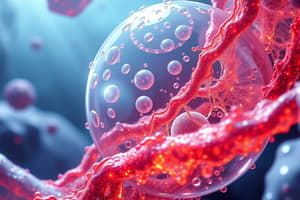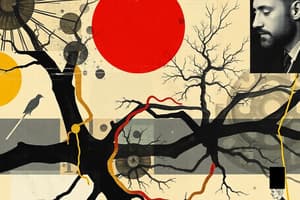Podcast
Questions and Answers
What is the function of glycocalyx on the cell surface?
What is the function of glycocalyx on the cell surface?
- Regulates entry and exit of ions
- Serves as a communication gateway
- Forms electrochemical gradients
- Provides important antigenic and functional properties (correct)
Which process involves cells ingesting particles like bacteria or dead cell remnants?
Which process involves cells ingesting particles like bacteria or dead cell remnants?
- Communication
- Phagocytosis (correct)
- Exocytosis
- Endocytosis
What is the role of membrane proteins in cells?
What is the role of membrane proteins in cells?
- Serves as receptors for molecular signals (correct)
- Forms glycocalyx
- Establishes electrochemical gradients
- Regulates entry of ions
Which component often has covalently attached oligosaccharide chains on the external membrane surface?
Which component often has covalently attached oligosaccharide chains on the external membrane surface?
What is the major function of phospholipids in the cell membrane?
What is the major function of phospholipids in the cell membrane?
Which process involves folding and pinching off of plasma membrane to form cytoplasmic vesicles?
Which process involves folding and pinching off of plasma membrane to form cytoplasmic vesicles?
Which type of cell is specialized for 'cell eating' (phagocytosis)?
Which type of cell is specialized for 'cell eating' (phagocytosis)?
Flashcards are hidden until you start studying
Study Notes
- The fluid mosaic model of membrane structure states that phospholipid bilayer of a membrane contains proteins inserted in it or associated with its surface, and these proteins move within the fluid lipid phase.
- Integral proteins are firmly embedded in the lipid layers, and those that completely span the bilayer are called transmembrane proteins. Hydrophobic amino acids of these proteins interact with the hydrophobic fatty acid portions of the membrane lipids.
- Selective permeability is a property of cell membranes that regulates entry and exit of ions, nutrients, and waste molecules through the membrane. Membrane proteins serve as receptors for various signals coming from outside cells and as selective gateways for molecules entering the cell.
- Membrane proteins, such as those for low-density lipoproteins and protein hormones, act as receptors at the cell surface. High-affinity binding of these ligands to their receptors causes aggregation of these proteins in special membrane regions, leading to invagination and pinching off internally as vesicles.
- Cells open and close specific channels for ions (such as sodium) across the membrane. Membrane components, including proteins and lipids, have externally exposed oligosaccharide chains that contribute to the cell's glycocalyx.
- Electron microscopy is a useful method for studying membrane structures by examining cryofracture preparation replicas. Most of the protruding membrane particles seen are proteins or aggregates of proteins attached to the half of the membrane adjacent to the cytoplasm, and fewer particles are found attached to the outer half.
- Vesicular transport, specifically endocytosis and exocytosis, is a process by which macromolecules enter cells by being enclosed within folds of the plasma membrane. Three major types of endocytosis are recognized: phagocytosis (ingestion of particles), pinocytosis (bulk fluid uptake), and receptor-mediated endocytosis (specific molecule uptake).
- The plasma membrane maintains an electrical charge difference across it through electrochemical gradients. Communication between cells occurs through receptors and connections.
Studying That Suits You
Use AI to generate personalized quizzes and flashcards to suit your learning preferences.




